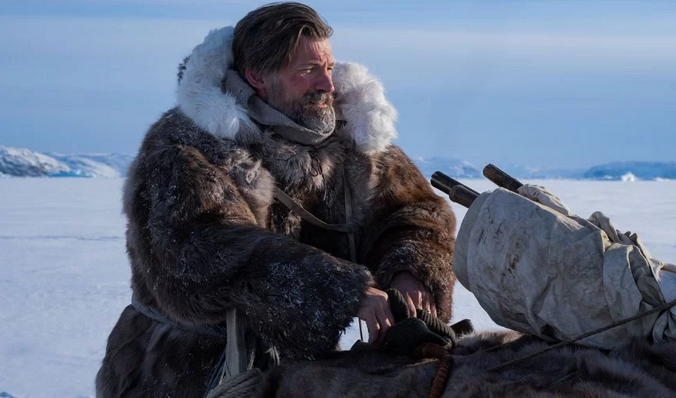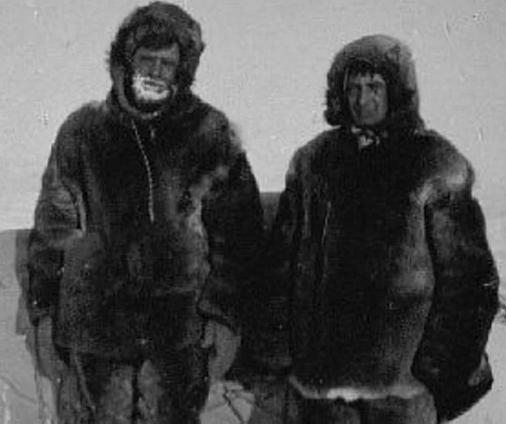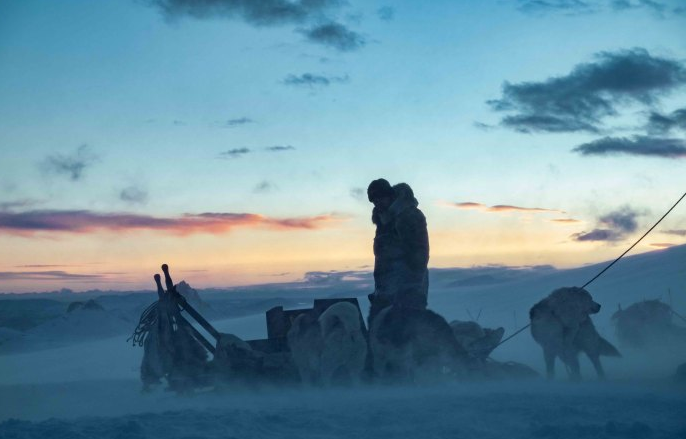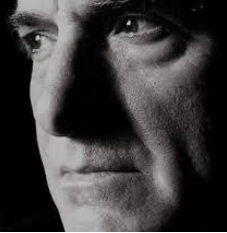
At the turn of the previous century, Arctic explorers—Alpha males born with an incredible self-belief in their abilities to achieve the impossible—travelled to places where nature held no respect for human life. —Nikolaj Coster-Waldau, introduction, Against the Ice
Greenland is an autonomous territory of the Kingdom of Denmark and the largest island in the world. Its population is made up mostly of Inuits, who originally migrated there in the thirteenth century from Alaska. It is physiographically part of North America, and the United States has been interested in acquiring it from Denmark since 1867.
Joe Dolce’s reviews appear in every Quadrant.
Click here to subscribe
US Navy Rear Admiral Robert Edwin Peary’s expedition to unexplored northern Greenland in 1891-92 suggested another landmass, separate and north of the main island. Maps of the early 1900s referred to this area as Peary Land and the water between as Peary Channel. The US wanted to claim Peary Land. Danish expeditions were mounted to prove that “Peary Land” was actually connected to Greenland.
The film Against the Ice tells the true story of the 1910 Alabama Expedition, the second Danish expedition launched to achieve this goal. An earlier attempt, the Danmark Expedition, had failed, resulting in the deaths of three of its senior members.
Against the Ice is a co-production between RVK Studios and Ill Kippers and was released on Netflix earlier this year. It was directed by Danish director Peter Flinth, on location in Iceland and Greenland, and is based on the 1955 Danish memoir Two Against the Ice, written by the captain of the Alabama Expedition, Ejnar Mikkelsen. The screenplay is co-written by Joe Derrick and Nikolaj Coster-Waldau, who plays Mikkelsen.
The story opens in 1910, on Shannon Island, north-east Greenland. It’s forty degrees below zero. The ship Alabama is locked in winter ice and a group of men are gathered around a table. The second-in-command, Carl Jørgensen, lying on his back, drinks whisky to dull the pain as his five black frostbitten toes are snipped off. They are celebrating Christmas; toasting the “men who gave their lives”, their three countrymen of the earlier Danmark Expedition. They have come to complete the Danmark’s failed mission. They have a map showing the location of a cairn where the Danmark leader, Mylius Erichsen, may possibly have left a report on his findings before he died. It was the custom of Arctic explorers to leave documents and maps in cairns so that, in the event of disaster, a log of their discoveries could aid subsequent explorations.
As Jørgensen can no longer walk, the captain of the Alabama, Ejnar Mikkelsen, asks for a volunteer to go out onto the ice with him to find this cairn. An inexperienced seaman and expert mechanic, Iver Iversen, is the only one willing to accompany him. Mikkelsen orders his men: “The sea opens up by July. If we are not back by August, then you leave without us.”
Mikkelsen and Iversen farewell their crew and depart on two dog sledges. Iversen has no previous experience with either sledges or dogs and becomes overly attached to his lead dog, Bjørn. They immediately encounter a precipitous mountain of ice that they have to ascend. Iversen’s sledge gets away from him and plunges over a cliff, hanging by a worn rope. Bjørn is lost but the sledge is recovered.
They are now struggling to find food, for themselves and their dogs. Iversen shoots one of the weaker ones to feed the others and the two men go onto half rations.
Iversen begins to express doubts about the wisdom of the journey and suggests turning back but Mikkelsen persuades him to persevere. They reduce their equipment to a single sledge and, shortly after, discover a cairn and the remains of a camp. Inside the cairn is a letter written by Mylius Erichsen, dated August 8, 1907, saying, “Peary Channel does not exist” and a map showing the fjord-like character of what is now Independence Bay. They now have their proof, and Mikkelsen declares: “Greenland is one. The US has no claim here.” They begin the four-and-a-half-month trek back to their ship.

A polar bear attacks Mikkelsen (the taller of the pair, above), and Iversen shoots it but the bear collapses on top of Mikkelsen, plunging him through the ice. After Iversen rescues Mikkelsen they discover that two of their remaining three dogs have been killed by the bear.
When their final dog dies, Mikkelsen burns the sledge and they decide to travel the last 200 miles back to the ship on foot. They construct a cairn of their own to preserve the map and letter in the event that they don’t make it.
They sight the tall mast of the Alabama in the distance, but then discover it has been removed from the ship and mounted into the ground. The timber from the ice-wrecked ship has been used to make a hut. The crew is gone.
Back in Copenhagen, Jørgensen and the remaining men, who have been rescued by a passing whaler, petition the Council President of Denmark, Niels Neergaard, to finance a voyage back for their two shipmates.
Now in their eighth month, Mikkelsen is still hopeful a rescue ship will come but Iversen is negative. Mikkelsen has a nightmare that the cairn they built was destroyed by a bear and decides they should return and retrieve the documents. Iversen suggests leaving a note for any possible rescue party who might come in their absence, but Mikkelsen talks him out of it.
They arrive at the cairn, which has indeed been scattered by a bear, but they recover the map and documents. When they arrive back at the hut, they find that someone has been there, left them a note and departed. Mikkelsen, in rage and frustration, destroys the remaining sledge.
Back in Copenhagen, Jørgensen reports to the Council that the rescue party discovered a hut that had recently been occupied and another rescue mission is organised.
The two men are now in their second year on the ice and Mikkelsen begins hallucinating. He climbs the mast and sees a hot-air balloon approaching, piloted by his fiancée, Naja. He rushes out to meet her and they embrace, but Iversen only sees him alone on the ice, gesturing in empty air.
Mikkelsen continues hallucinating, communicating with his fiancée daily, and now begins to distrust Iversen.
The food stores are almost gone, with only one rifle cartridge remaining. They see a bear outside the hut trying to break into their storeroom but drive it away by banging pots and yelling.
It is now 1912 and they have been stranded for two and a half years. When they hear what they assume is another bear outside, Iversen prepares to shoot it with their remaining round. Mikkelsen throws open the door, to reveal a rescue party.
Returning to Copenhagen, with the documents proving Peary’s map is inaccurate, their evidence leads to American recognition of Greenland as a single island belonging to Denmark, and Iversen and Mikkelsen are celebrated as national heroes.
The book Two Against the Ice, written by Ejnar Mikkelsen, was translated from the Danish by Maurice Michael and published in English in 1955. The original Danish title, Farlig Tomansfaerd, means literally “Dangerous Tomorrow”. The book is dedicated: “To my loyal and cheerful companion in north-east Greenland from 1909 to 1912, Iver P. Iversen.”

Mikkelsen was born in 1880, in Jutland, Denmark. As a child he dreamt of becoming a famous explorer, and went to sea for the first time when he was fourteen years old. In 1896, his application to accompany the Swedish explorer Salomon Andrée on an Arctic balloon flight was fortunately rejected, as the balloon failed to reach the North Pole and crashed, killing all three occupants.
Queen Margrethe II of Denmark was working as a costume designer on an adaptation of the Hans Christian Andersen fairy tale “The Wild Swans”, directed by Peter Flinth, and she suggested to Flinth that Mikkelsen’s book would make a good film. Flinth sent a copy of it to his friend Nikolaj Coster-Waldau.
Mikkelsen’s memoir diverges from the movie script in several ways.
In real life, Iversen had been hired to replace the previous ship’s mechanic, a useless drunk. Iversen was a genius mechanic who could repair anything. He had previously volunteered for the initial trek in which Jørgensen lost his toes and had already proved himself on the ice with sledge and dogs, on the initial 700-mile, eighty-six-day exploration. It was agreed that he would also join Mikkelsen and Jørgensen on the second longer trek, the one portrayed in the film. There was no further volunteering required. When Jørgensen became disabled by frostbite, it left the two men to make the journey alone.
There was no love story in the book between Mikkelsen and Naja and no hot-air-balloon hallucination. There was no polar bear attacking Mikkelsen on the ice. Long before Iversen and Mikkelsen arrived back at their ship, they were aware that the crew would have departed as ordered. It was not the surprise to them that the film depicted.
The two men did not build a proper cairn to secure their documents but, as Mikkelsen recalled: “wrapped in an old shirt and stuffed into a crack in the rocks, beneath a stone so that no storm could scatter the contents, lay our diaries, [and] Mylius Ericksen’s reports”. They left the material primarily to lighten their load as they were now travelling on foot, but planned to return immediately for the documents once they had reached camp, found food and recovered their health.
In Mikkelsen’s book, Lost in the Arctic, Being the Story of the “Alabama” Expedition, 1909–1912, published a year after the rescue, he wrote:
April 23, 1911: The journey is a succession of monotonous days, one just like another. We turn out, have our meal, haul like a couple of horses for ten hours, camp, eat again, and sleep … and beyond it nothing happens until we reach the little rocky island where our diaries were left. We pitch our tent in silence, and silently we begin digging about the snow … suddenly something glistens … it is our old tea tin … we dig away with renewed energy, casting the snow to right and left, and now we begin to find things in earnest. A diary, a note-book full of observations, a roll of film and some cartridges. One of the last named has been bitten flat by a bear—it would have served him right if it had exploded in his inside.
Iversen did not suggest leaving any note for potential rescuers when they went on this recovery trek and no rescue party arrived while they were gone.
There were also no official rescue missions initiated by Jørgensen. The successful rescue was made by Captain Paul Lillenaes, of the Sjøblimstena, a sealing vessel. Lillenaes was after the 10,000-crown reward offered by the government. He accidentally stumbled on a piece of driftwood onto which Mikkelsen had carved his initials and a recent date and deduced, correctly, that this meant that the two men (and the reward!) could be close at hand. After a short search, he discovered Mikkelsen and Iversen.
To illustrate the courage and resilience of Iversen, who is portrayed in the film as somewhat of a fumbling amateur, Mikkelsen recounts that at one stage the senior officer had developed scurvy so bad that he couldn’t stand and had to be lashed to the sledge to keep from falling off. For five weeks, Iversen drove the sledge by himself, with all their supplies, and Mikkelsen helpless on board.
The novel is rich with detail that is missing from the film. The ship acquired by Mikkelsen for their journey was called the Alabama and he remarked that “the name was strange to Danish eyes … but it is an old superstition of the sea that you should be very [careful] of changing a good ship’s name before a long and dangerous voyage, for grief and misfortune may result from denying a ship her past”.
They had originally purchased fifty sledge dogs from west Greenland for the trek, but the dogs had been so mistreated on their sea voyage to them that they became infected with rabies. All fifty had to be shot. Mikkelsen subsequently found and purchased smaller replacement dogs from local Eskimos.
He recounts how the sledge dogs always fought. Usually, the males would compete with each other over the bitches in heat, but after most of the males were lost in their preliminary ice trek, the ratio became four females to each male—the bitches in heat became the aggressors for the remaining males.
Once, the two men found an unusual surprise in the snow, a bottle of beer:
It was a queer looking bottle of beer, for in the freezing, the beer had forced the cork out and was protruding from the neck of the bottle like a bent finger some four inches long. We broke off the finger, thawed the beer in a pan and tried to pretend that it tasted all right.
Finally, upon arriving home in Copenhagen, Mikkelsen exclaimed, “Having a bath again after three years!”
Reviews of Against the Ice have been mixed. Matt Glasby of the Radio Times wrote: “The scenery is beautiful, the action is solid … and viewers of ice-bound adventures such as The Terror [reviewed in Quadrant, September 2019] and The North Water [reviewed in December 2021] will know what to expect.”
David Ehrlich of Indiewire wasn’t so kind: “Forget The Terror, here comes The Tedium.” But Jared Mobarak of Filmstage said:
How can you not get pulled in by the intrigue of a grizzled veteran and enthusiastic, naive amateur teaming up to do the impossible? The potential for tense drama and action is boundless. I do believe Against the Ice is a success insofar as it shows ability to memorialise these unsung heroes braving elements to do right by their people.
Although Admiral Robert E. Peary’s map was incorrect, with mistaken information leading indirectly to the death of the three members of the earlier Danmark Expedition, according to a 1916 Geographical Review:
In the long progress of charting the world’s coasts some things are “put on the map”, to be taken off again as detailed surveys take the place of reconnaissance journeys and actual traverses and maps are substituted for sketches and hypotheses based on distant views.
[Peary] made a sledge journey across Greenland which up to that time had no equal in polar exploration … [and] opposed the United States giving up its claim to Greenland, believing that doing so violated the Monroe Doctrine. He wanted to purchase the island for mineral wealth and to avoid foreign bases that would, as air and sea technology improved, threaten his country.
The US Monroe Doctrine was intended to prevent expansion of foreign sovereignty in the Americas.
The British author Fergus Fleming, in his book Ninety Degrees North: The Quest for the North Pole (2003), described Peary as “undoubtedly the most driven, possibly the most successful and probably the most unpleasant man in the annals of polar expedition”.
In 1921, Denmark formally declared sovereignty over all of Greenland but US General Billy Mitchell still argued for American bases in Greenland and Iceland. When the Nazis invaded Denmark in 1940, Germany attempted to make a legal claim on Greenland but, even before war was declared, the US, applying the Monroe Doctrine, landed armed Coast Guard personnel to defend the island, due to its proximity to mainland America. It was also the only known significant source of cryolite, essential in the refinement of aluminium.
In 1946, President Harry Truman offered to purchase Greenland from Denmark for $100 million in gold, even offering to throw in parts of Alaska. Vice-President Nelson Rockefeller, in the 1970s, reportedly suggested buying Greenland for its resources. President Donald Trump mentioned purchasing it as recently as 2019, saying, “strategically, for the United States, it would be nice”. Greenland’s Minister of Foreign Affairs tweeted a reply to the President on Twitter: “We’re open for business, not for sale.”
The United States currently maintains Thule Air Base on Greenland, which houses the 12th Space Warning Squadron. Since 1959 the island has been part of NORAD, the North American Aerospace Defense Command.
Ejnar Mikkelsen continued exploring into the 1930s. On his ninetieth birthday, in 1970, a national tribute was paid to him in Denmark. He died several months later. The twenty-three-kilometre Ejnar Mikkelsen Range in King Christian IX Land, eastern Greenland, was named in his honour. On All That’s Interesting, Marco Margaritoff wrote: “With a Greenland mountain range named after him, the explorer had truly become the kind of famed adventurer he dreamed of as a child.”
 Sign In
Sign In 0 Items (
0 Items ( Search
Search










One to put on the list for Netflix watching, and thanks for the further information about the real-life situation. Sounds like a good tale has been constructed (somewhat artificially as they do) out of this interesting piece of history. A good shared bottle of red will help with any tedium involved should it occur.
This story reminded me of the Hans Island saga, whose ownership was disputed between Canada and Denmark up until this year.
This small island is in the very centre of the Kennedy Channel between Greenland and Canada’s most northerly island, Ellesmere Island in the high Arctic region, and it is barren and uninhabited.
In 1984, a scientist with a Canadian oil company was found exploring on the island. The Danish Minister of Greenland Affairs came to the island himself the same year with the Danish flag, a bottle of Schnapps, and a letter stating “Welcome to the Danish Island” (Velkommen til den danske). It is commonly held that it was a bottle of Gammel Dansk, which translates literally to ‘Old Danish’. The Canadians reciprocated with their own ‘Welcome to Canada’ sign, the flag of Canada and a bottle of Canadian Club.
The two countries proceeded to take turns planting their flags on the island and exchanging alcoholic beverages. The flags were folded properly and respectfully. There have also been Google ads used to “promote their claims”. Despite the seriousness, it was all done in a friendly manner.
A border has now been agreed which makes it the most northerly international land border in the world and the third shortest land border – 1.28 km.